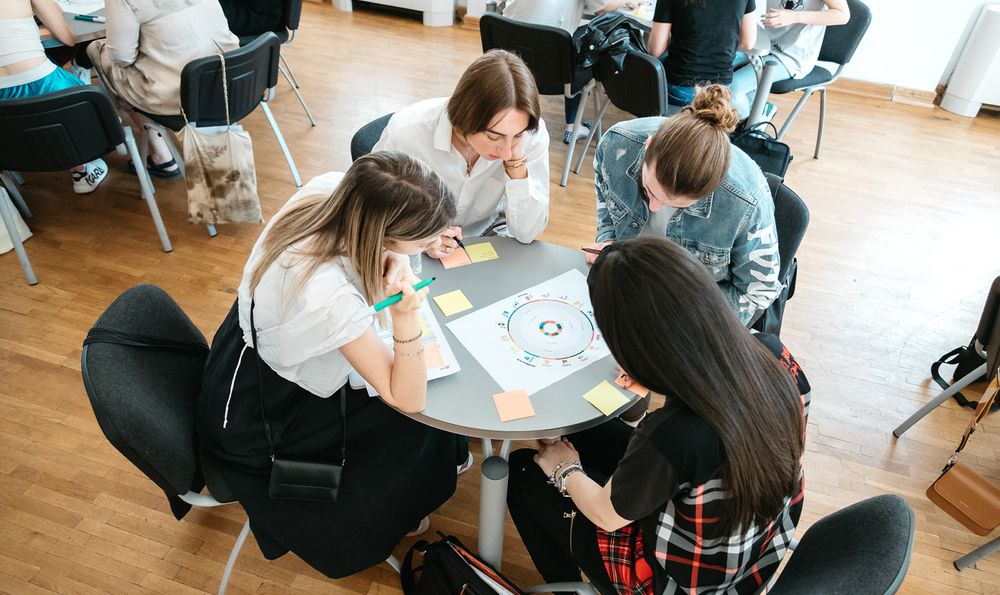Visual Thinking is an approach that uses graphical tools, images and visualisations, to help simplify concepts, learning and memorisation by making information clearer and more direct.

Visual Thinking methodology to enhance learning
Date
22 April 2024
What is Visual Thinking?
Visual Thinking, also known as Visual Learning, is a communication technique that uses images, symbols and drawings to organise and share ideas and concepts, facilitating learning and problem solving. This method levereages our natural ability to remember what we "see" more effectively than what we read or hear.
The ability to translate projects, even complex ones, into visual language is essential for concretising communication and facilitating the sharing of information, enhancing creativity, innovation, and learning speed.
The benefits of Visual Thinking
The methodology of Visual Thinking consists of an initial phase dedicated to pure creativity, followed by a phase where the initial idea or ideas are put down on paper in the form of drawings, concept maps, or PowerPoint presentations.
Among the various advantages, Visual Thinking:
- Enhances thee understanding of complex concepts
Through the use of images and diagrams, Visual Thinking helps eliminate cognitive barriers, enabling faster and deeper comprehension . Diagrams, concept maps and illustrations transform complicated data i into easily interpretable shapes and colours,, allowing one to quickly grasp the relationships between different parts of a topic and to see the big picture more clearly.
- Improves memory retention
Visual representations stimulate multiple areas of the brain simultaneously, helping to anchor processes and ideas in the memory and improving long-term recall. Images, diagrams or mind maps reinforce the memory of information, making it easier to recall it later. Moreover, images often evoke emotions, which can further cement the information in the memory.
- Enhancees engagement during presentations and meetings
These techniques make presentations and meetings dynamic and interesting, capturing the attention of participants and improving overall communication. The use of visual elements keeps attention high and encourages more active participation, so attendees feel more engaged and motivated to contribute.
- Stimulates creativity and problem solving
The use of diagrams and images stimulates the generation of new ideas and promotes creative solutions to existing problems, facilitating brainstorming and innovation. Visualising problems and possible solutions through flowcharts, mind maps or sketches can help to draw connections that would not be obvious with written text alone. This visual approach allows different perspectives to be explored, fostering more flexible and innovative thinking.
- Optimises productivity
Visualising goals and priorities through maps and charts ensures that all team members are on the same page, facilitating collaboration and focusing on common goals. Visual tools provide a clear and shared view of tasks to be performed, deadlines and responsibilities. This improves workflows and communication within the team, and also helps to quickly identify any “bottlenecks” or areas that need attention, therefore optimising overall efficiency.
How to apply Visual Thinking
Visual Thinking makes use of a wide range of visual techniques and tools that completely transform the way we learn, work and communicate our ideas. Some of the most frequently used techniques to maximise effectiveness in the representation and understanding of information are:
- Mind maps: these are diagrams representing relationships between different concepts from a central idea. They can be used for brainstorming or for organising information in a neat and organised manner.
- Diagrams: these are essential for representing processes or workflows. This technique can illustrate complex steps simply and linearly, facilitating the understanding of. operations and sequence of actions.
- Sketches and drawings: these help visualise concepts and solutions while also stimulating creativity and innovation. In a design workshop, for example, sketches can be used to explore different design possibilities, allowing the team to clearly see all the possible alternatives.
- Storyboards: these are sequences of images that tell a story or illustrate a series of events. This can be useful in the planning of presentations, videos or advertising campaigns, where it is essential to have an idea of how the visual impact will look before the actual execution.
Visual Thinking and active learning
Visual Thinking combines effectively with active learning methodologies such as “learning by doing” and “cooperative learning”, offering a dynamic and engaging approach to education and teamwork.
In learning by doing, for example, Visual Thinking helps visualise the steps in the process or the results of an experiment, making the experience more concrete and memorable. However, with cooperative learning, where the focus is on collaboration and the exchange of ideas, communication and integration of different perspectives is simplified and made more effective. By creating a common visual representation, group members can literally see how their ideas fit together, promoting a deeper understanding and collective commitment to shared goals.
In this way, Visual Thinking not only enhances individual learning, but also collaborative learning, transforming educational sessions into more interactive and productive experiences.
Visual Thinking in IED courses
If you want to incorporate Visual Thinking techniques into your daily work or enrich your CV with this skill, explore IED's training offerings. You will find a wide range of courses in marketing, communication and design, designed for professionals from different sectors. Through theoretical and practical training courses, you will acquire innovative tools and methodologies that will allow you to improve your ability to communicate, collaborate and solve problems creatively.








